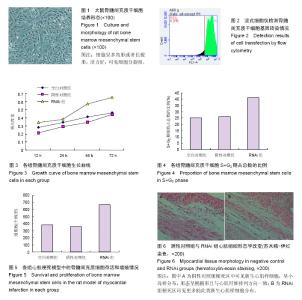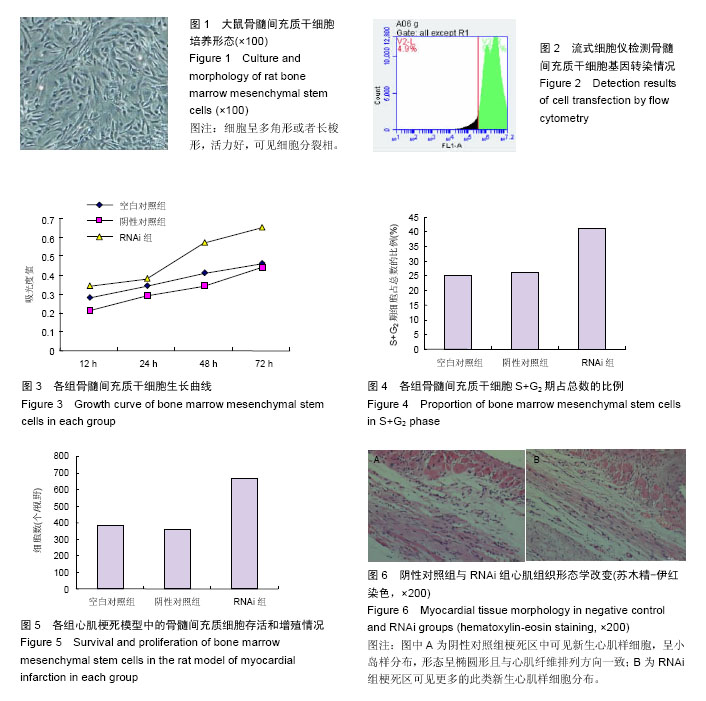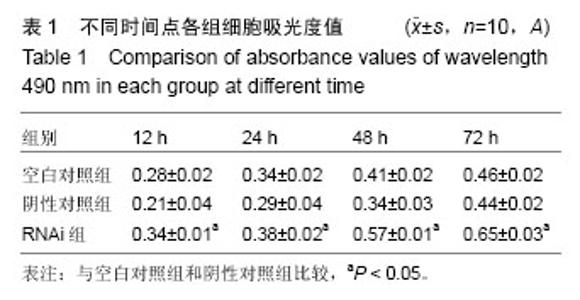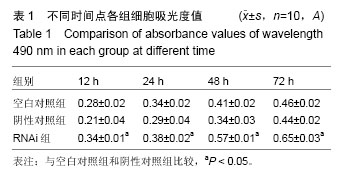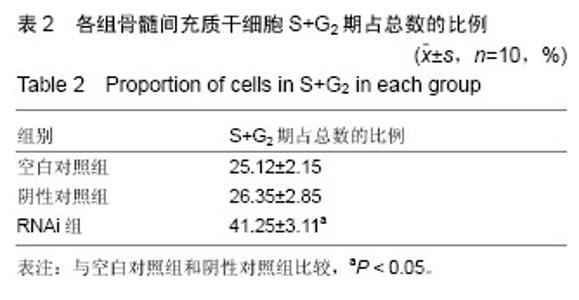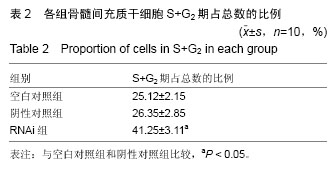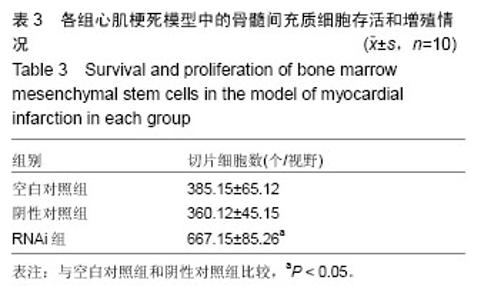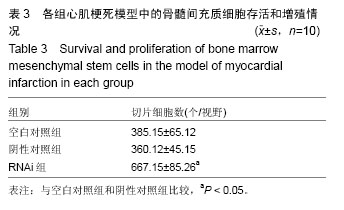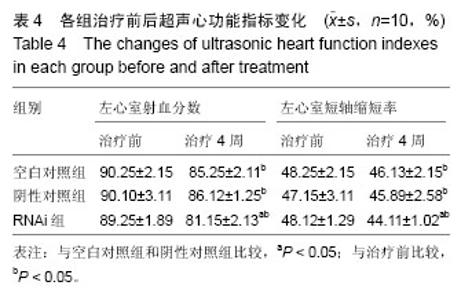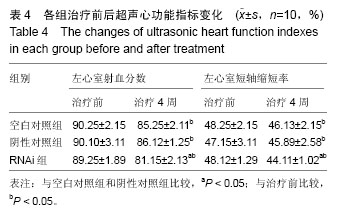| [1] 王东,张建军,杨卫山,等.NgR基因沉默骨髓间充质干细胞/许旺细胞支架复合体的构建[J].中国组织工程研究,2012, 16(25):4591-4595.
[2] 陈毅,尹西盟,董宝铁,等.PTEN基因沉默对BMSC氧糖剥夺模型的保护作用及其对Bcl-2凋亡通路的影响[J].中国医科大学学报,2011,40(7):600-604.
[3] 赫天,张海宁,项金瑜,等.环氧化酶2基因沉默不影响人骨髓间充质干细胞定向分化的能力[J].中国组织工程研究, 2014,18(14):2140-2146.
[4] Rosner M, Siegel N, Fuchs C, et al. Efficient siRNA-mediated prolonged gene silencing in human amniotic fluid stem cells. Nat Protoc. 2010;5(6):1081- 1095.
[5] 郑丽芳,梅元武,张小乔,等.Snail基因沉默对转化生长因子-β1促进骨髓间充质干细胞迁移的抑制作用[J].解剖学报,2008,39(5):717-722.
[6] Greco SJ, Smirnov SV, Murthy RG, et al. Synergy between the RE-1 silencer of transcription and NFkappaB in the repression of the neurotransmitter gene TAC1 in human mesenchymal stem cells. J Biol Chem. 2007;282(41):30039-30050.
[7] Alessio N, Bohn W, Rauchberger V, et al. Silencing of RB1 but not of RB2/P130 induces cellular senescence and impairs the differentiation potential of human mesenchymal stem cells. Cell Mol Life Sci. 2013;70(9): 1637-1651.
[8] 雷莹,陈杭,许红,等.PTEN基因的沉默对骨髓间充质干细胞体外生物学特性和体内移植治疗心肌梗死的影响[J].临床心血管病杂志,2011,27(4):307-312.
[9] 赫天.慢病毒载体介导COX-2基因沉默在有骨髓间充质干细胞中的表达及对干细胞定向分化能力影响的研究[D].青岛:青岛大学,2014.
[10] 龙乾发,汪平,王安生,等.Hes1基因沉默促进骨髓间充质干细胞向GABA能神经元分化的实验研究[J].中华神经外科杂志,2014,30(2):186-189.
[11] 梁博伟,潘新元,赵劲民,等.沉默膜联蛋白A1基因影响兔骨髓间充质干细胞的增殖及成骨分化能力[J].中国组织工程研究,2012,16(19):3421-3426.
[12] Kotini AG, Mpakali A, Agalioti T. Dnmt3a1 upregulates transcription of distinct genes and targets chromosomal gene clusters for epigenetic silencing in mouse embryonic stem cells. Mol Cell Biol. 2011; 31(7):1577-1592.
[13] Ackermann M, Lachmann N, Hartung S, et al. Promoter and lineage independent anti-silencing activity of the A2 ubiquitous chromatin opening element for optimized human pluripotent stem cell-based gene therapy. Biomaterials. 2014;35(5): 1531-1542.
[14] 郑丽芳,梅元武,张小乔,等.转化生长因子β1促进骨髓间充质干细胞迁移与上调Snail表达有关[J].中国组织工程研究,2012,16(23):4253-4258.
[15] 刘家良,华平,杨淞然,等.沉默caspase-3基因影响骨髓间充质干细胞的增殖和凋亡[J].中国组织工程研究,2013, 17(14):2480-2487.
[16] 张伟,刘雪芹,苗苗,等.20S蛋白酶体β5亚单位基因沉默对人骨髓间充质干细胞增殖能力的影响[J].解剖学杂志, 2015, 38(2):153-156.
[17] 黄冠,许梅,余俊,等.myocardin基因沉默在PDGF-BB诱导小鼠骨髓间充质干细胞向平滑肌样细胞分化中的作用[J].中华病理学杂志,2009,38(2):117-120.
[18] 华平,刘家良,杨淞然,等.慢病毒介导的caspase-3沉默对大鼠骨髓间充质干细胞增殖和凋亡的影响[J].中国病理生理杂志,2013,29(8):1502-1507.
[19] Reddy BY, Greco SJ, Patel PS, et al. RE-1-silencing transcription factor shows tumor-suppressor functions and negatively regulates the oncogenic TAC1 in breast cancer cells. Proc Natl Acad Sci U S A. 2009;106(11): 4408-4413.
[20] 陆超,陈吉庆,周国平,等.Par-4基因沉默对人骨髓间充质干细胞中Smac基因表达和半胱氨酸蛋白水解酶3酶活性的影响及其抗凋亡作用[J].中华医学杂志,2008,88(6): 411-415.
[21] 曾彬,童随阳,王欣,等.整合素连接激酶增加缺血环境下骨髓间充质干细胞生存率和血管内皮生长因子分泌[J].中华实验外科杂志,2014,31(11):2506-2508.
[22] 林在俊,肖建如,罗剑,等.大鼠Smad6慢病毒干扰载体的构建与鉴定[J].国际骨科学杂志,2011,32(6):386-388, 391.
[23] Graf P, Dolzblasz A, Würschum T, et al. MGOUN1 encodes an Arabidopsis type IB DNA topoisomerase required in stem cell regulation and to maintain developmentally regulated gene silencing. Plant Cell. 2010;22(3):716-728.
[24] Kalberer CP, Pawliuk R, Imren S, et al. Preselection of retrovirally transduced bone marrow avoids subsequent stem cell gene silencing and age-dependent extinction of expression of human beta-globin in engrafted mice. Proc Natl Acad Sci U S A. 2000;97(10):5411-5415.
[25] 王倩,程堃.Gankyrin基因沉默对人卵巢癌SKOV3/CDDP细胞顺铂耐药性的逆转作用和机制[J].中国癌症杂志, 2014,24(1):35-40.
[26] 韦永琼,曾照芳,陈力学,等.构建和鉴定PTEN基因的shRNA重组腺病毒表达载体[J].南方医科大学学报, 2009,29(12):2414-2417,2420.
[27] Jägle S, Rönsch K, Timme S, et al. Silencing of the EPHB3 tumor-suppressor gene in human colorectal cancer through decommissioning of a transcriptional enhancer.Proc Natl Acad Sci U S A. 2014;111(13): 4886-4891.
[28] 刘敏丽,李刚,胡迎春,等.多效生长因子基因沉默抑制PTEN基因敲除细胞的增殖[J].军事医学科学院院刊, 2006,30(2):113-115,121.
[29] 吴强.慢病毒载体介导siRNA沉默PTEN基因促进脊髓损伤修复的实验研究[D]. 天津:天津医科大学,2013.
[30] Han Y, Li N, Tian X, et al. Endogenous transforming growth factor(TGF) beta1 promotes differentiation of smooth muscle cells from embryonic stem cells: stable plasmid-based siRNA silencing of TGF beta1 gene expression. J Physiol Sci. 2010;60(1):35-41.
[31] Pfeifer A, Ikawa M, Dayn Y, et al. Transgenesis by lentiviral vectors: lack of gene silencing in mammalian embryonic stem cells and preimplantation embryos. Proc Natl Acad Sci U S A. 2002;99(4):2140-2145.
[32] 王思涵.Ⅰ.NRSF基因沉默促进干细胞向胰岛β样细胞分化的研究;Ⅱ.小分子化合物Me6对辐射损伤组织的修复作用及其机制的研究[D].北京:解放军军事医学科学院, 2013.
[33] 曹丰,贾国良,牛丽丽,等.移植时机对骨髓间充质干细胞修复梗死心肌的影响[J].第四军医大学学报,2005, 26(1): 22-27.
[34] 吴祖常,吴国才,吴智明,等.干细胞生长因子和粒细胞集落刺激因子与心肌梗死大鼠体内骨髓间充质干细胞的迁移[J].中国组织工程研究与临床康复,2011,15(36): 6737-6740.
[35] 解飞.梗死区骨髓间充质干细胞注射对心肌梗死猪心脏结构形态及心功能的影响[J].山东医药,2015, 55(21): 28-29.
[36] 刘金峰,凌斌.骨髓间充质干细胞对心肌梗死治疗的研究进展[J].中国医学科学院学报,2015,37(1):108-112.
[37] 孙津津,刘朝中,张海涛,等.体外心肌梗死微环境下大鼠骨髓间充质干细胞向内皮样细胞的分化[J].中国组织工程研究与临床康复,2011,15(14):2471-2476.
[38] 林楚伟,周胜华,刘启明,等.骨髓间充质干细胞诱导心脏成纤维细胞向肌纤维母细胞转化:不同时期心肌梗死区域的最佳微环境[J].中国组织工程研究与临床康复,2010, 14(36):6667-6671.
[39] 陈岩,杨关林,白雪松,等.穴位注射骨髓间充质干细胞后心肌梗死大鼠血管细胞黏附因子1及迟发抗原4的表达[J].中国组织工程研究,2014,18(45):7290-7293.
[40] 李金轶,钟国强,何燕,等.同种异体骨髓间充质干细胞移植对大鼠心肌梗死后心电生理异常和左室重构的影响[J].中国组织工程研究与临床康复,2009,13(27):5211-5216. |
